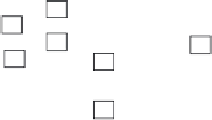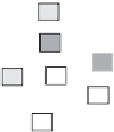what-when-how
In Depth Tutorials and Information
together, so they cannot be used to determine the community configuration. It
might be necessary to point out that design C is the worst one, since all the four
objects are spread out in the network. In Figure 16.2, the shaded nodes represent
the four objects.
Now, let us consider another situation with a more complex query (see
Figure 16.3). Suppose we have two yellow objects (in circles), two red objects (in
squares), and eight nodes in the social network. he two yellow objects and the
two red objects belong to different communities. Let us consider a network A
with the two red and two yellow objects connected together with two nodes and
the remaining six nodes linked together. Let us design a network B with each of
the four objects spread out, but with each of them linked to two regular nodes.
Lastly, let us have a network C with two yellow objects connected to one node,
the two red objects linked to two other nodes, and the leftover nodes linked to
one another. In this situation, we can say that design C is the suitable one to
discover the community structure. However, designs A and B have either both
yellow and red objects linked together with some nodes or spread out, so they will
be inefective for our studies. he following diagram is actually the representation
of the three networks A, B, and C discussed earlier.
Network A
Network B
Network C
he two foregoing examples show that community mining depends on what kind
of relations users have between objects; also, we observe that a user's query may be
very flexible, which supports our new idea that community mining methods need
to concentrate on the multirelational network.
Since one of our main aims is to determine a linear combination that best
describes the community structure, we might find some formulas for the relation
extraction problem. Let
V
be a set of nodes and
E
i
a set of edges. From that, we can
define a set of graphs
G
i
=
(
V,E
i
)
, where
i
=
1,.…,.
n
. In addition, let
M
i
represents
Network A
Network B
Network C
Figure 16.3
Networks with more complex query. (From Cai, D. et al. 2005.
Mining hidden community in heterogeneous social networks. In
Proceedings
of the 3rd International Workshop on Link Discovery
(Chicago, Illinois, August
21-25,2005).LinkKDD'05.ACM,NewYork,58-65.)
















